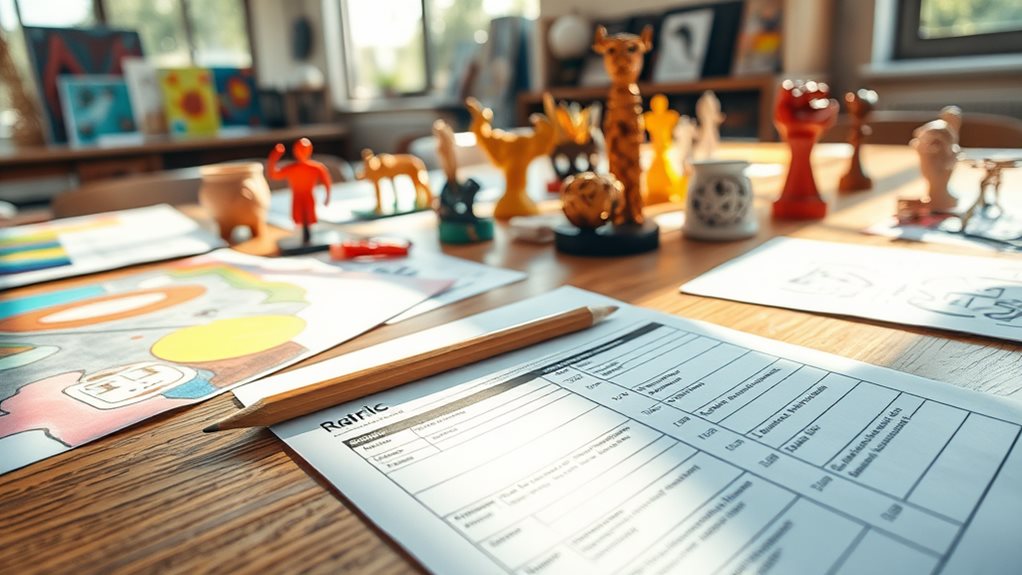Using rubrics to assess creativity and originality helps you define measurable criteria tailored to specific tasks. You'll target dimensions like originality, fluency, and flexibility while setting clear performance levels. By customizing rubrics, you ensure alignment with discipline-specific goals and provide actionable feedback. Encouraging a growth mindset through constructive criticism allows students to see creativity as a developable skill. Examples and benchmarks clarify expectations, fostering deeper engagement. Further exploration offers insights into refining your approach.
Defining Creativity in Educational Settings
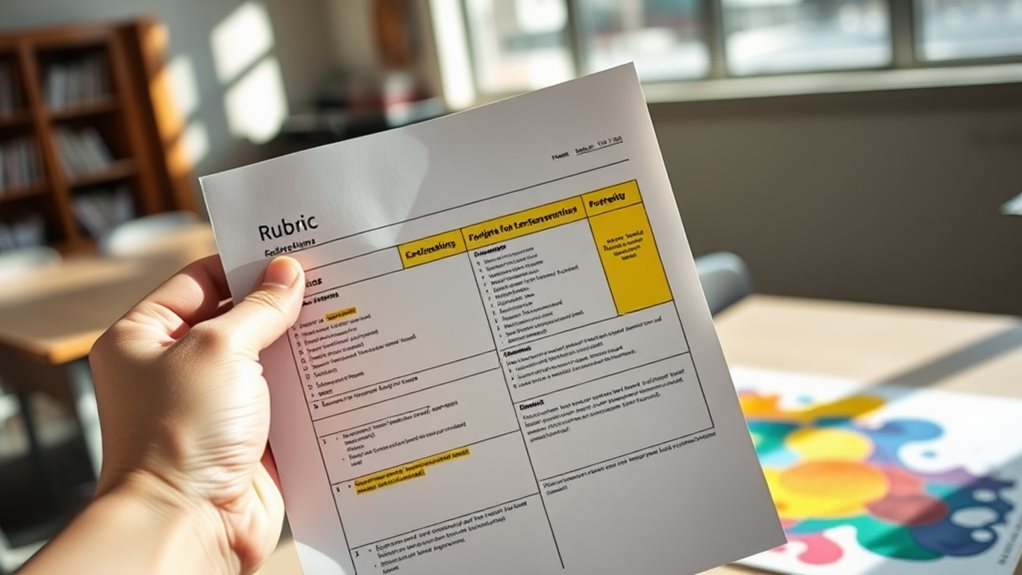
When defining creativity in educational settings, you need to understand it as more than just producing something original. It's about crafting work of high quality that reflects originality and depth. True creativity isn't about replicating what's already been done; it's about constructing new ideas and meaningful connections that stand out. This means students must observe, interpret, and synthesize details in ways others might overlook.
In the classroom, creativity often manifests as:
- Originality: Generating ideas or solutions that are novel and unique.
- Usefulness: Ensuring the creative output has value or solves a problem.
- Fluency: Producing a large quantity of ideas or responses.
- Flexibility: Shifting perspectives or approaches to tackle challenges.
- Elaboration: Adding depth, detail, or complexity to the work.
However, assessing creativity isn't straightforward. Without clear criteria, you risk misinterpreting students' efforts. For instance, a project might seem creative at first glance, but if it lacks originality or fails to address the task's requirements, it doesn't truly meet the mark.
That's why defining creativity with precision is crucial. You need a framework that evaluates not just the end product but also the thought process behind it.
Consider this: A student's artwork might be visually striking, but if it's heavily derivative of a famous piece, it lacks true originality. On the other hand, a simple sketch that reimagines a common object in an innovative way could demonstrate deeper creativity. The key is to recognize both the novelty and the execution of the idea.
To assess creativity effectively, you must:
- Establish clear criteria that align with educational goals.
- Focus on both the process and the product.
- Provide constructive feedback that encourages further exploration.
Establishing Clear Criteria for Creativity Assessment
Establishing clear criteria for creativity assessment is critical to ensuring your evaluations are both meaningful and actionable. Without well-defined dimensions, your assessments risk being subjective or inconsistent. To create a rubric that truly measures creativity, you need to focus on specific dimensions that capture the multifaceted nature of creative work. These dimensions include originality, usefulness, fluency, flexibility, elaboration, and complexity. Each of these elements provides a lens through which you can evaluate the depth and breadth of your students' creative outputs.
- Originality: How unique or novel is the idea? Does it show a departure from conventional thinking?
- Usefulness: Is the idea practical or applicable in a real-world context? Does it solve a problem or fulfill a need?
- Fluency: How many ideas or solutions does the student generate? Ideation quantity often correlates with creative potential.
- Flexibility: Does the student demonstrate the ability to shift perspectives or approaches? Flexibility indicates adaptability in thinking.
- Elaboration: How well-developed is the idea? Does the student add details, refine concepts, or expand on their initial thoughts?
- Complexity: Does the idea show depth or layers of thinking? Does it integrate multiple concepts or perspectives?
To make these dimensions actionable, you must assign specific performance levels. For example, use a scale of 1 to 4, where 1 indicates minimal creativity and 4 represents exceptional creativity. Accompany each level with detailed descriptors that clarify what distinguishes one level from another. For instance, under "Originality," a level 1 might describe an idea that's conventional or derivative, while a level 4 would showcase an idea that's groundbreaking or transformative.
Customizing the rubric to fit your specific discipline or task is equally important. A creativity rubric for a science project might emphasize usefulness and complexity, while one for an art assignment might focus more on originality and elaboration. Tailoring the criteria ensures the rubric aligns with your learning objectives and the nature of the task.
Include examples or benchmarks to illustrate different levels of creativity. For instance, provide a sample of student work that achieved a level 4 in "Elaboration," explaining why it met that standard. This not only helps you maintain consistency in grading but also gives students a concrete understanding of what excellence looks like.
Finally, treat your rubric as a living document. Regularly review and refine it based on student performance and feedback. If you notice that certain criteria are consistently misunderstood or misapplied, revise the language or add more examples. This iterative process ensures your rubric remains clear, consistent, and effective in assessing creativity.
Designing Rubrics for Originality and Quality
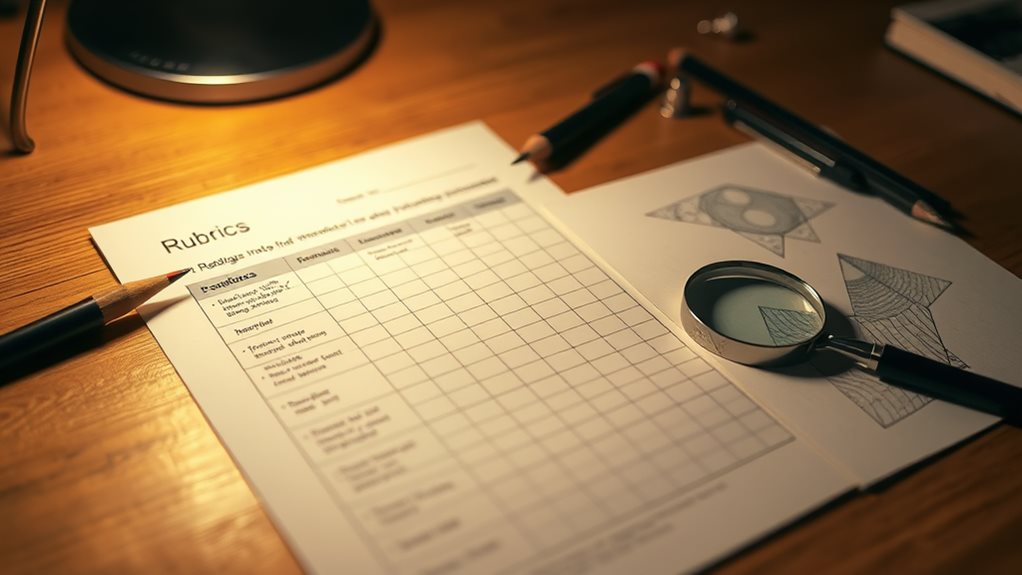
Designing rubrics for originality and quality starts with defining clear, measurable criteria that directly target the dimensions of creativity. You need to evaluate aspects like fluency—how many ideas are generated, flexibility—the diversity of those ideas, elaboration—the depth of detail, and complexity—the sophistication of the concept. Without these specifics, your rubric won't effectively distinguish between levels of creative performance.
Each performance level in your rubric must be distinctly defined. Use qualitative labels like *novice*, *competent*, *proficient*, and *exemplary* to clarify expectations. For example, under "Originality," a novice might produce predictable ideas, while an exemplary level showcases innovative, unexpected solutions. These distinctions give students a clear roadmap for where they currently stand and what they need to aim for.
Customization is key. Align rubric dimensions to your specific discipline or task. If you're assessing a design project, criteria might include aesthetic appeal and technical execution. For a writing assignment, creativity might focus on narrative structure and originality of voice. Tailoring the rubric ensures it reflects what truly matters in the context of the work.
Balance is critical. Your rubric should reward both technical skills and creative expression. For instance, a high-quality painting might demonstrate mastery of brushwork while also evoking a unique emotional response. Leave room for personal interpretation, but maintain clear expectations for quality to avoid subjective grading.
Regular feedback and adjustments are essential. After using the rubric, analyze student performance. Are students consistently scoring low on one dimension? Does the rubric align with your educational goals? Use these insights to refine the criteria, ensuring it remains an effective tool for assessing creativity and originality.
- Define clear criteria for creativity dimensions: fluency, flexibility, elaboration, complexity.
- Use qualitative labels to distinguish performance levels: novice, competent, proficient, exemplary.
- Customize rubric dimensions to align with your discipline or task.
- Balance technical skills and creative expression in your criteria.
- Refine the rubric based on feedback and student performance.
Strategies to Stimulate Creative Thinking
Brainstorming sessions are your secret weapon to unlock creative potential. When you encourage students to generate ideas freely, without immediate judgment, you create a safe space for innovation. This approach boosts their confidence and allows them to explore unconventional solutions.
To make it effective, set clear guidelines: no criticism during the session, and quantity matters more than quality at this stage. You'll be amazed at how this simple technique can spark creativity.
Assignments that blend different concepts or subjects are game-changers. When you ask students to combine ideas from science with art or history with technology, you force them to think in new ways.
For example, a project that merges storytelling with coding challenges them to see connections they might otherwise miss. These interdisciplinary tasks stimulate their minds and lead to unexpected, innovative outcomes.
Giving students a choice in their project topics is a powerful motivator. When they pick something they're passionate about, they take ownership of their work.
This sense of relevance drives them to invest more effort and creativity. For instance, instead of assigning a standard essay topic, let them choose a subject that resonates with their personal interests. You'll see their engagement and creativity soar.
Clear criteria for creative assignments are essential. When students know what's expected, they feel more confident in taking risks.
Define parameters like originality, depth of thought, and presentation quality. For example, in a creative writing task, you might assess how effectively they use metaphors or develop characters. These criteria guide them while still leaving room for imagination.
Encourage students to draw from diverse sources to enrich their work. Whether it's personal experiences, cultural references, or interdisciplinary knowledge, these inputs add depth and originality to their creations.
For example, a student writing a poem might include elements from their family history or a science concept they recently studied. This approach not only enhances their creativity but also makes their work more meaningful.
- Brainstorming: No judgment, focus on quantity.
- Interdisciplinary assignments: Combine subjects for innovation.
- Student choice: Foster ownership and relevance.
- Clear criteria: Define originality and quality.
- Diverse sources: Blend personal and academic insights.
Balancing Technical Proficiency and Creative Expression

Balancing technical proficiency and creative expression is crucial when designing rubrics to assess creativity effectively. You need to ensure that students are evaluated not only on their mastery of relevant skills but also on their ability to innovate and express originality. This dual focus creates a comprehensive framework that values both discipline-specific expertise and artistic ingenuity.
When crafting your rubric, consider including distinct criteria for technical skills and creative elements. For instance, in a music assessment, you might evaluate rhythm accuracy and pitch precision as technical components, while emotional conveyance and originality would fall under creative expression. This approach ensures that students understand the importance of both aspects in their work.
- Clearly define performance levels for each criterion. Descriptive language should differentiate between technical competence and creative contributions.
- Use examples to illustrate what "exemplary" looks like in both areas. For instance, an exemplary creative portfolio might demonstrate innovative problem-solving, while technical excellence might include flawless execution.
- Adapt the rubric based on student feedback and performance data. Regularly revising your criteria ensures they remain aligned with educational goals and student needs.
Providing Constructive Feedback on Creative Work
When providing feedback on creative work, your focus should be on two critical pillars: originality and execution. Recognize the unique ideas your students bring to the table while also addressing their technical proficiency. This balance ensures they understand that both innovative thinking and skill refinement are essential.
Constructive criticism is your most powerful tool for fostering growth. Instead of vague statements like "This needs work," give specific, actionable insights. For example, if a student's painting lacks depth, suggest techniques like layering or shading to enhance the composition. This not only points out areas for improvement but also provides a clear path forward.
- Highlight what's working: "Your use of color here is striking and evokes strong emotion."
- Challenge for growth: "Next time, experiment with varying brushstroke techniques to add texture."
- Encourage exploration: "Have you considered blending abstract and realistic elements to push your style further?"
Balancing praise with challenges is key to motivating your students. Acknowledge their technical skills—be it their mastery of perspective in drawing or their ability to craft compelling narratives in writing. But don't stop there. Challenge them to stretch their creative boundaries. For instance, if a student excels at traditional storytelling, encourage them to experiment with nonlinear structures or unconventional genres.
Specific suggestions are non-negotiable for meaningful improvement. Instead of saying, "This could be more original," guide them with prompts like, "What if you reimagined this scene from an entirely different perspective?" or "How might you incorporate an unexpected element to surprise your audience?" These prompts push them to think beyond their comfort zone while giving them a tangible starting point.
Comprehensive feedback should always highlight strengths alongside areas for improvement. This approach fosters a growth mindset, showing students that creativity is a journey, not a destination. For example:
- Strength: "Your character's dialogue feels natural and engaging."
- Area for improvement: "Consider adding more internal monologue to deepen their emotional complexity."
Examples of Creativity in Student Assignments
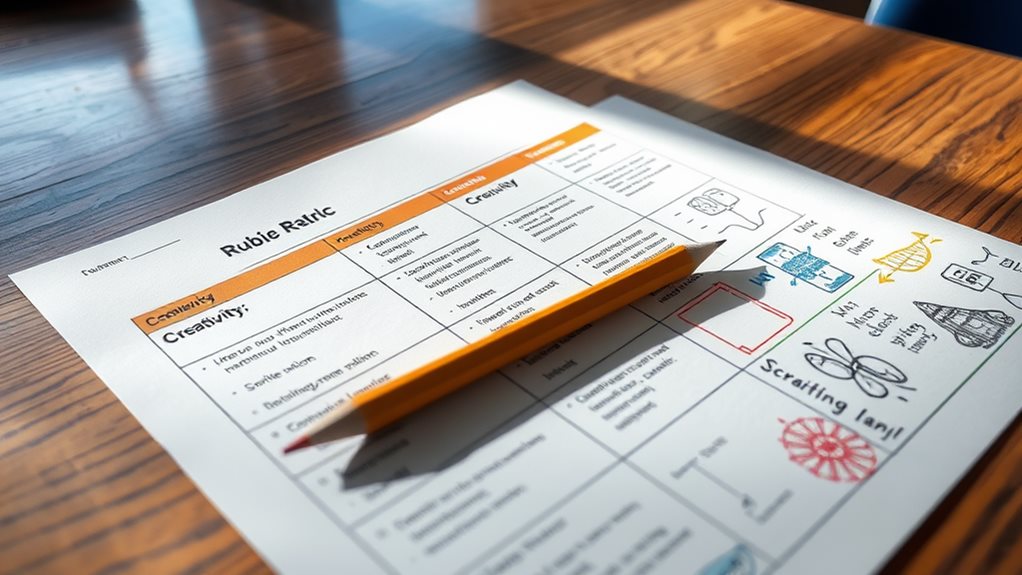
When assessing creativity in student assignments, you need to look for how students present a variety of ideas or contexts. Evaluating originality means observing how students combine existing concepts to produce something new. For example, a student might take a familiar narrative structure—like a hero's journey—and weave it into a modern context, such as a climate change crisis. This demonstrates not just understanding but also innovative thinking.
Encourage students to communicate interesting or surprising concepts in their work. This could be through a presentation or a written reflection. For instance, a student might present a science project and explain how they drew inspiration from a natural phenomenon, like how bees build hives, to design an energy-efficient structure. The ability to articulate these connections showcases creativity and depth.
Assess how students incorporate diverse sources into their assignments. A student who integrates personal experiences, such as family traditions or cultural practices, into an essay or art project demonstrates a higher level of creativity. For example, a student might use their grandmother's recipes as a foundation for a history project on immigration patterns, blending personal narratives with academic research. This enriches the work, making it more original and engaging.
Recognize varying levels of originality when evaluating creativity. Compare a standard drawing of a landscape to one that includes unexpected elements, like a futuristic cityscape superimposed over a mountain range. The latter invites viewers to speculate and ask questions, indicating a more creative approach.
Use assessment rubrics with specific criteria for originality and quality to identify strengths and areas for improvement. For example:
- Originality: Does the work present a unique perspective or recombine existing ideas in a novel way?
- Quality: Is the execution polished, thoughtful, and engaging?
- Depth: Does the work demonstrate a meaningful connection to diverse sources or personal experiences?
Adapting Rubrics for Diverse Subject Areas
To effectively assess creativity across diverse subject areas, you need to adapt your rubrics to align with the unique objectives and requirements of each discipline. While creativity is a universal skill, its expression varies significantly depending on the context. For instance, originality in art may look like innovative use of color or technique, whereas in science, it could manifest as groundbreaking problem-solving or experimental design. Your rubrics must reflect these nuances to ensure they accurately measure creativity in context.
Start by identifying the specific dimensions of creativity relevant to each subject. In literature, you might focus on narrative originality or thematic depth, while in engineering, creativity could be tied to innovative design solutions or efficiency. Tailor your evaluation criteria to these dimensions, ensuring they're both rigorous and adaptable.
Incorporate subject-specific examples and benchmarks to guide both students and educators. For example, in a visual arts rubric, you might include descriptors like "demonstrates a unique visual style" or "effectively uses symbolism to convey meaning." In contrast, a rubric for mathematics might emphasize "applies unconventional problem-solving strategies" or "synthesizes multiple concepts to arrive at a novel solution." These examples provide clarity and make the rubric more accessible.
Allow for flexibility in performance levels to accommodate varied expressions of creativity. A rigid rubric can stifle creativity, so aim for descriptors that acknowledge multiple pathways to success. For instance, in a music assessment, high performance levels could include "explores unconventional harmonic structures" or "integrates diverse cultural influences into composition."
Finally, regularly review and revise your rubrics based on feedback and evolving learning outcomes. Subject areas are dynamic, and your rubrics should evolve too. Engage with colleagues and students to ensure your criteria remain relevant and effective. This iterative process not only improves the rubric but also fosters a culture of continuous improvement in assessing creativity.
Encouraging a Growth Mindset Through Rubric Use
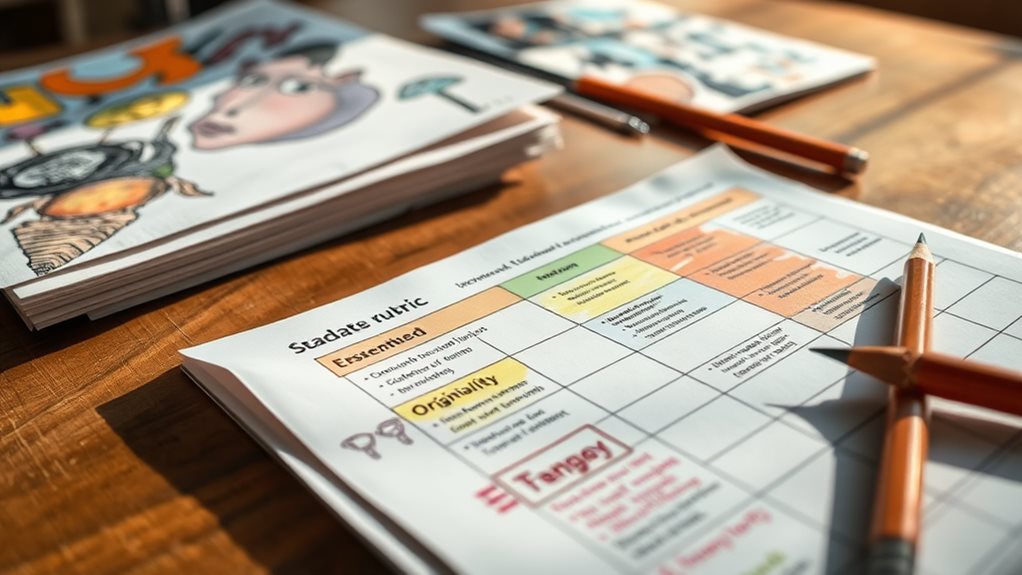
Rubrics are powerful tools for fostering a growth mindset in students, and when used effectively, they can transform how your learners approach creativity. By designing rubrics that highlight both strengths and areas for improvement, you encourage students to focus on their progress rather than fixate on the final product. This shift in perspective helps them see creativity as a skill that can be developed over time, not a fixed trait.
When providing feedback through rubrics, focus on specific suggestions for enhancement. For example, instead of simply marking "needs improvement," offer actionable steps like "consider experimenting with bolder color choices to enhance visual impact." This approach reinforces the idea that creativity is a process, and every iteration brings them closer to mastery.
Here's how you can use rubrics to instill a growth mindset:
- Celebrate originality and execution: Highlight unique ideas and well-executed elements in their work. This validates their efforts and encourages them to take creative risks.
- Define performance levels clearly: Break down criteria into distinct levels, showing students where they currently stand and what's needed to reach the next level. This clarity helps them recognize their potential for growth.
- Incorporate constructive criticism: Frame feedback in a way that emphasizes learning. For instance, "This concept has potential; refining the details will make it even stronger" positions mistakes as opportunities for improvement rather than failures.
Questions and Answers
How Can Rubrics Be Used in Authentic Assessment?
You can use rubrics in authentic learning by designing them to align with creativity metrics and assessment practices. Incorporate student feedback to refine rubric design, ensuring it evaluates process and product effectively.
How Can Creativity Be Measured and Creative Outcomes Be Assessed?
You measure creativity through creativity metrics like originality benchmarks, fluency, and flexibility. Assess outcomes using subjective evaluation paired with artistic criteria, ensuring innovative expression is recognized alongside technical skill for a comprehensive creative assessment.
Do Rubrics Stifle Creativity?
Rubrics can impose creativity constraints if overly rigid, limiting innovative thinking and artistic expression. However, with rubric flexibility, you'll strike an assessment balance that fosters originality while maintaining clear expectations for creative work. Adjusting criteria helps avoid stifling potential.
How Can Rubrics Be Used to Assess Skills?
You can use rubrics for skill assessment by designing them with clear criteria and performance levels. They'll enhance feedback effectiveness, align with learning outcomes, and boost student engagement by providing structured guidance for improvement.
